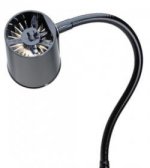crrmeyer
Stainless
- Joined
- Nov 10, 2006
- Location
- Southern California
So I ended up a while back with a Nichols tool room horizontal mill at the agreeable "get it out of here" price. It had been converted to a non-geared 3 Hp 3 phase motor with a single drive pulley. Getting tired on one speed, I purchased a nice 3 Hp Pacific Scientific industrial 180VDC permanent magnet motor. I am in the process of removing the original motor control, drum direction switches and power switch to convert to a KB DC motor controller.
I would like to mount a spare Moffatt task lamp with a PR30 led reflector bulb (7 watts at 120VAC).
I have two possible ways of powering it.
1) add a long 120VAC cord and fine an unused outlet somewhere.
2) Add a small 240V to 120V step down transformer to power the LED bulb. I am packaging the drive electronics anyway so there is some space to add a fuse and transformer.
I am tempted to use option 2 as it will be the cleanest wiring. Any thoughts on how many VA I would need for a 7W 120VAC led bulb? I know know the obvious answer is slightly more than 7VA, but I have been burned in the past by step up/down transformers and odd load currents causing overheating issues.
Thanks
I would like to mount a spare Moffatt task lamp with a PR30 led reflector bulb (7 watts at 120VAC).
I have two possible ways of powering it.
1) add a long 120VAC cord and fine an unused outlet somewhere.
2) Add a small 240V to 120V step down transformer to power the LED bulb. I am packaging the drive electronics anyway so there is some space to add a fuse and transformer.
I am tempted to use option 2 as it will be the cleanest wiring. Any thoughts on how many VA I would need for a 7W 120VAC led bulb? I know know the obvious answer is slightly more than 7VA, but I have been burned in the past by step up/down transformers and odd load currents causing overheating issues.
Thanks





